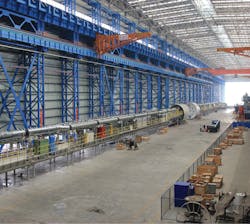SFMTA Asks Public to Vote on Tunnel Boring Machine Names
The San Francisco Municipal Transportation Agency (SFMTA), which oversees transportation in the city, including the Municipal Railway (Muni), today announced that the public may vote online to name the tunnel boring machines (TBMs) that will excavate and construct the Central Subway tunnels.
The TBMs will be named after historic San Francisco women. An online poll commenced Friday and will continue until Jan. 23. Voters can select up to two names from the following options: Big Alma, Juana, Mom Chung, Firebelle Lil and Mary Ellen.
To vote, please visit www.centralsubwaysf.com/TBM-name.
In tunneling tradition, the custom of naming TBMs is believed to bring good luck to tunneling projects. The names will remain in official use by the SFMTA and the tunneling contractor as the TBMs excavate and construct the Central Subway’s northbound and southbound tunnels, traveling from SoMa through Union Square, Chinatown and North Beach.
“The TBMs will be named after prominent pioneering women who have shaped our City’s rich and historic past, just as the Central Subway will help shape San Francisco’s innovation future,” said Mayor Edwin M. Lee. “We are excited to involve the people of San Francisco in this fun and important tunneling tradition,” said Mayor Edwin M. Lee. “We are excited to involve the people of San Francisco in this fun and important part of tunneling tradition.”
“The Central Subway will connect San Francisco’s diverse communities, significantly improving transportation along some of our busiest, most populated and fastest growing corridors,” said SFMTA Board of Directors Chairman Tom Nolan. “By naming the TBMs after trailblazing San Francisco women, we are honoring the city’s exciting history while contributing to its outstanding future.”
Fabrication of the TBMs takes approximately a year. The TBMs are expected to arrive in San Francisco in March. Each TBM consists of a rotating cutter wheel (the cutter head), a cylindrical steel shell (the shield) and a 300-foot train of tunnel-building mechanisms (the trailing gear). The TBMs will arrive in several parts, to be assembled at the site on 4th Street between Harrison and Bryant streets where tunneling will begin later this year.
The public may vote to name the TBMs after these historic San Francisco women:
“Big Alma” de Bretteville Spreckels (1881-1968): Known as "Big Alma" (she was 6 feet tall) and "The Great-Grandmother of San Francisco,” Alma de Bretteville Spreckels was a wealthy socialite and philanthropist who, among her many accomplishments, persuaded her first husband, sugar magnate Adolph B. Spreckels, to fund the design and construction of the California Palace of the Legion of Honor, at Land’s End in San Francisco. A model in her youth, Spreckels was the inspiration for the “Victory” statue atop the Dewey Monument in the center of Union Square.
Juana Briones (1802-1889): A talented farmer, rancher, healer and businesswoman, Juana Briones was one of the first women to own land in California and one of the first residents of San Francisco in its early days, when it was called Yerba Buena. In 1835 she fled her abusive husband and settled with her seven children in what is now North Beach. There she raised cattle and sold produce to provide for her family. She also worked as a healer, assisting sick and deserted sailors in this new frontier town. A plaque commemorating her contribution to the city can be found in Washington Square Park.
Dr. Margaret “Mom” Chung (1889-1959) was the country’s first female Chinese-American physician, practicing in the heart of San Francisco’s Chinatown. During World War II she “adopted” more than a thousand “sons,” most of them American servicemen, mentoring them, sending them presents and sharing meals with them during and after the war. She was also one of the earliest supporters of women in the Navy. When one of her “sons” became a congressman, he filed the first legislation to create a female branch of the Navy in response to a phone call from “Mom Chung.”
Lillie “Firebelle Lil” Hitchcock Coit (1843-1929) was a well-known volunteer firefighter and the benefactor for the construction of Coit Tower. At the age of 15, she became involved in San Francisco’s volunteer fire department, eventually becoming an honorary member of Knickerbocker Engine Co. No. 5. Coit was also an avid gambler, and she smoked cigars and wore trousers long before it was socially acceptable for women to do so. Upon her death she left one-third of her estate to the City of San Francisco “for the purpose of adding beauty to the city which I have always loved.” The money was used to build Coit Tower. Coit also commissioned the statue of three firefighters at the northwest corner of Washington Square Park.
Mary Ellen Pleasant (c1814-1904): A leader in the abolitionist movement who was known as the mother of civil rights in California, Mary Ellen Pleasant brought the Underground Railroad to California and led a successful campaign in the 1860s to desegregate the streetcars of San Francisco. Her lawsuit set a precedent in the California Supreme Court that influenced later civil rights cases. Pleasant arrived in San Francisco in the early 1850s after fleeing prosecution in the East for helping slaves escape to freedom. An entrepreneurial businesswoman, she eventually owned a chain of laundries and boardinghouses, bought real estate and worked as a matchmaker. She continued to help runaway slaves by employing them at her businesses.
